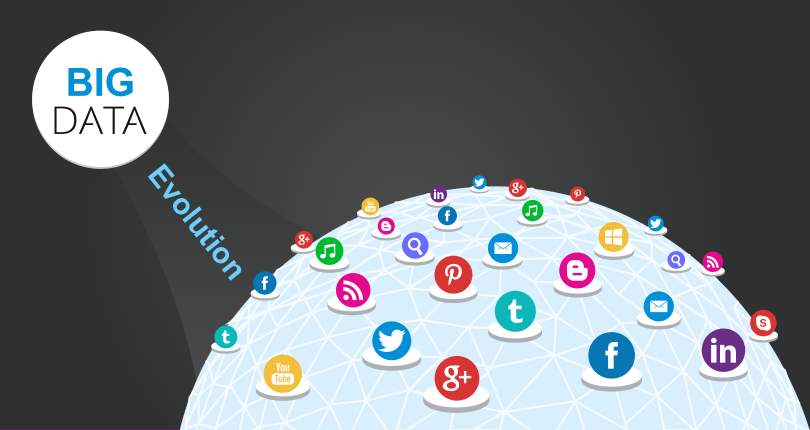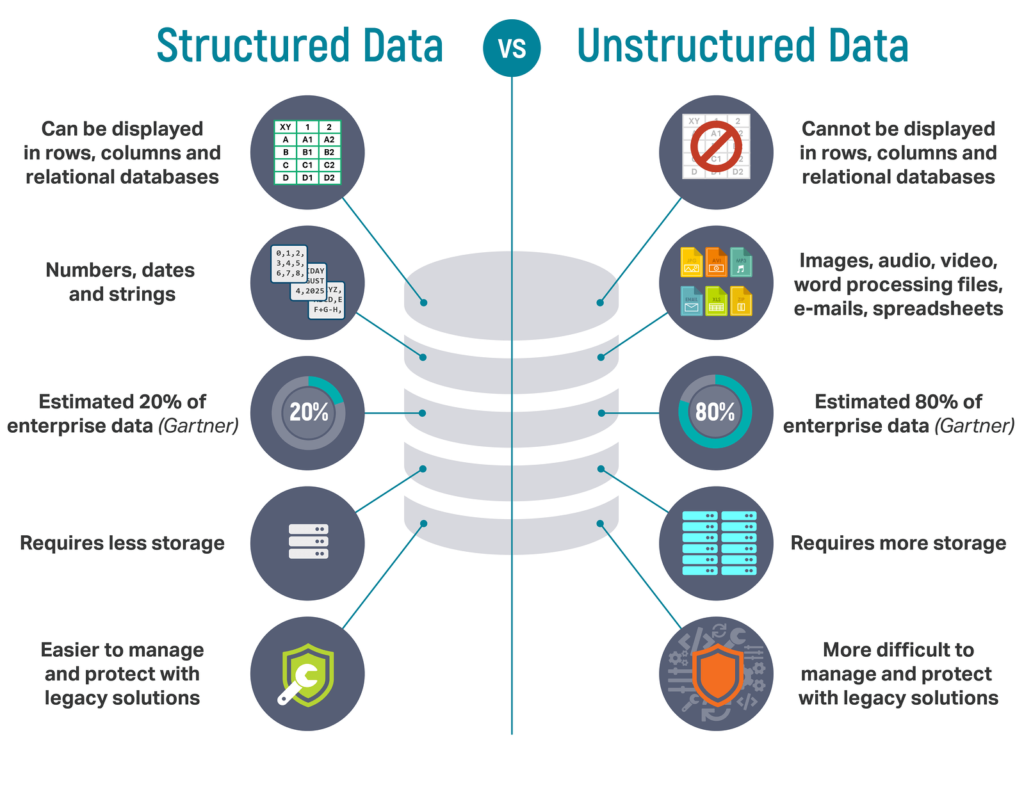
Evolution of Big Data as mentioned earlier in part-1 of this blog series, Big data used without that coined name since we started moving into caves. The size and comprehension of data evolved as we as a human evolved in culture and technology. At any given time or situation, when the amount of data becomes too large, uncontrollable, and response, we build systems to interpret and analyze the data. We can say that even devices like Abacuses are instruments that help us analyze/calculate the data at hand.
However, the amount of data consumed by human society has risen beyond comprehension in the last two decades. And especially in the last decade, the data is rising through the roof, or in this case through the sky. The total amount of data in the world was 4.4Zettabyte (1zettabyte=roughly 1000 exabytes, 1 exabyte = 1000 petabytes, and 1 petabyte = roughly 1000 terabytes) in 2013 and is expected to rise to 44Zettabyte in 2020, which we crossed easily.
And expected to reach 175 Zettabyte in 2025. The comprehension of such a huge data volume is impossible without the development of the technology both to interpret and consume. Even with such increasingly advanced technologies, it is impossible to process all these data.
Evolution of Big Data
The evolution of Big Data is explained in three phases.

Evolution of Big Data: Structured Data
The Database management system is the origin of Big Data and Data analytics. The techniques like storage, extraction, and optimization techniques used in Relational Database Management System were relied upon heavily by the Database management at that time. The first phase of the evolution of big data consisted of database management and database warehousing.
Modern data analytics later formed as an evolution of the database management system. At the time it used techniques like database queries, database processing, and reporting tools. Modern, complex big data solutions often use non-relational databases in their architecture and require a comprehensive quality assurance approach.

Evolution of Big Data: HTTP Based Data
The inception of the Internet and WWW started introducing vast new and unique opportunities in terms of data collection and analyses. The commercialization of personal computers by companies like Microsoft, Apple, and IBM, etc., and the availability of internet by internet providers made it easy for more people to access the internet which increased the web traffic through the roof.
This increase in web traffic brought new types of data collected and analyzed for various purposes. Search engines like Google, Yahoo, etc. helped collect data about trends in various industries. Similarly, the birth of social media platforms such as Facebook, Twitter, etc helped companies collect and analyze data about public behavior, consumer behavior, interests, etc. Thus, the opportunity to collect new types of data and resulting analyses opened possibilities beyond comprehension.
This massive increase in the amount of data by the HTTP-based web traffic was mostly semi-structured and unstructured data from a data analytics point of view. Due to this nature of data, the organizations needed to figure out new techniques to store, interpret, and analyze these new data types. The need to interpret the vast amount of data from social media platforms and eCommerce websites. They then convert them into meaningful information and became the need of the hour.
Evolution of Big Data: Sensor-Based Data
Many organizations in data analytics consider these semi/unstructured data as the focus. New opportunities to retrieve important data from mobile devices have created a whole new world of possibilities. The third phase of Big Data is dominated by biometric data by IoT devices. Devices like wearable activity trackers allow companies to track health-related data. Along with the user location tracking allows them to analyze much new useful information. Because of these internet-based sensor devices, the data generation is on a different level.
The sensors are embedded in all forms of machines. From daily appliances like washing machines, and refrigerators to cars, trucks to even warehouses to track the inventories. The possibilities of use of these data are endless. The best part is we have only begun to extract/analyze the information from these sources.

Conclusion
Therefore, Data is the most important and powerful commodity in the modern world. At PromptCloud, we do our part in this evolution by servicing companies that require web-based data. We provide fully managed, enterprise-grade, end-to-end web scraping solutions. Make sure to stay tuned into this 3 part series on the evolution of Big Data and its advancements in the last and final part which will be soon published.
Frequently Asked Questions
#1: What is big data and its evolution?
Big data refers to vast volumes of structured, semi-structured, and unstructured data that cannot be processed using traditional data processing techniques. This data is generated from various sources, including social media, sensors, online transactions, and web scraping. Big data is characterized by the “3 Vs”: Volume (large amounts of data), Velocity (the speed at which data is generated), and Variety (the different types and formats of data).
Evolution of Big Data:
- Early Stages (1990s-2000s):
Big data concepts emerged as internet usage grew and companies began collecting large amounts of user and transaction data. Traditional databases couldn’t scale to meet this new demand, leading to the development of distributed systems and storage solutions like Hadoop and NoSQL databases, allowing organizations to handle larger datasets. - Era of Analytics (2010s):
As big data storage and processing improved, the focus shifted to extracting insights. Companies began using advanced analytics tools like machine learning, artificial intelligence, and data mining to uncover patterns and trends, driving smarter decision-making. - Present Day:
Today, big data is more accessible and integral to business strategies. Real-time data processing and cloud-based platforms enable companies to gather and analyze massive datasets from multiple sources quickly and cost-effectively. Web scraping, for example, plays a critical role in extracting valuable information from the web, contributing to big data insights in industries like e-commerce, finance, and healthcare.
The evolution of big data has empowered businesses to make data-driven decisions, understand customer behavior, and stay competitive in a data-driven world.
#2: What are the origins of big data?
The origins of big data can be traced back to the increasing demand for large-scale data storage, processing, and analysis that arose with the growth of the internet, digital technologies, and interconnected systems. Here’s a brief timeline of how big data emerged:
- Early Computing and Data Collection (1960s-1980s):
The concept of managing large datasets began with the introduction of early computers and databases. Organizations started collecting and storing more data from transactions, scientific research, and government records. However, traditional databases and processing systems were limited in terms of scale and capacity. - The Rise of the Internet (1990s):
The true origins of big data are closely tied to the rapid expansion of the internet in the 1990s. As more users and businesses went online, massive amounts of data were generated daily. This period saw the introduction of search engines, e-commerce platforms, and social media, creating an unprecedented surge in data that traditional storage systems couldn’t handle. - Web 2.0 and Data Explosion (Early 2000s):
The emergence of Web 2.0 marked the shift toward user-generated content, social media, and interactive web applications. Companies like Google, Facebook, and Amazon began collecting vast amounts of data from user interactions, search behavior, and online purchases. This gave rise to the need for new technologies capable of processing and storing this flood of unstructured data. - Technological Advances (2000s-Present):
To address the growing need for large-scale data handling, technologies like Hadoop, NoSQL databases, and cloud computing were developed. These innovations allowed organizations to process, store, and analyze massive amounts of structured and unstructured data efficiently. The introduction of distributed computing and parallel processing made it possible to work with petabytes of data, paving the way for today’s big data landscape. - Big Data Analytics and Real-Time Processing (2010s-Present):
Today, big data has evolved into an essential resource for industries across the globe. With advances in artificial intelligence, machine learning, and real-time data processing, companies can extract valuable insights from enormous datasets. Web scraping, for instance, has become a key method for acquiring real-time data from websites to fuel business intelligence and decision-making.
The origins of big data are rooted in the need to manage the exponential growth of data from digital and online sources, and its evolution continues to shape the way businesses and organizations operate in the modern world.
#3: How has data evolved over time?
The evolution of data has mirrored advancements in technology, the internet, and the way businesses and individuals generate and consume information. Here’s a look at how data has evolved over time:
1. Pre-Digital Era (Before the 1960s):
In the early days, data was primarily stored in physical forms such as ledgers, paper documents, and filing systems. Data collection was manual, and processing or analysis was slow and limited by human effort. Large-scale data management was almost nonexistent, as there were no systems to handle it efficiently.
2. The Rise of Digital Data (1960s-1980s):
With the advent of computers, data began to transition from physical records to digital formats. Databases like SQL (Structured Query Language) emerged to manage structured data efficiently. Large organizations, governments, and industries started using computers to store and process data for accounting, scientific research, and other business functions.
Key Development: Early relational databases that made it easier to manage and retrieve data quickly.
3. The Internet and the Data Boom (1990s):
The widespread adoption of the internet in the 1990s led to a massive surge in data generation. Websites, emails, and e-commerce platforms created vast amounts of digital data, most of which was unstructured (not neatly organized in databases). Traditional databases struggled to keep up with the volume, variety, and velocity of this data.
Key Development: The concept of “big data” began emerging as businesses realized they needed more advanced systems to manage increasingly complex datasets.
4. Web 2.0 and User-Generated Data (2000s):
The early 2000s brought about Web 2.0, where users became active participants in generating data. Social media platforms, blogs, video sharing sites, and e-commerce reviews contributed to an explosion of user-generated content. This data was unstructured, often text-heavy, and vast in quantity. This era also saw the rise of NoSQL databases and frameworks like Hadoop to handle unstructured and semi-structured data.
Key Development: The shift from structured, transactional data to unstructured, real-time data generated by users.
5. The Age of Big Data and Advanced Analytics (2010s-Present):
The ability to store and process massive amounts of data improved significantly with advancements in cloud computing, distributed systems, and scalable data storage solutions. Companies like Google, Amazon, and Facebook began using advanced data analytics tools to extract valuable insights from data in real-time. Machine learning and artificial intelligence (AI) became integral to processing and analyzing vast amounts of complex data, turning it into actionable insights.
Key Development: Real-time data processing, AI, machine learning, and predictive analytics transformed how data is used to drive business decisions.
6. The Future: Real-Time Data, IoT, and AI (Present and Beyond):
Today, data continues to evolve with the growth of the Internet of Things (IoT), which connects millions of devices and sensors that generate continuous streams of data. Real-time data processing is now essential for businesses to remain competitive. AI-driven tools are being increasingly used to manage, analyze, and interpret data in ways that were previously unimaginable.
Key Development: Automated, AI-powered data analysis tools, along with real-time data gathering from IoT devices and sensors, will shape the future of data.
Data has evolved from physical records to highly complex, real-time digital information. The introduction of new technologies, from relational databases to AI and real-time processing, has revolutionized the way we store, manage, and analyze data. Today, data is the backbone of decision-making, with industries relying on it to drive innovation and stay competitive.
#4: How big is the evolution of data?
The evolution of data has been monumental, shaping nearly every aspect of modern life, business, and technology. To understand the magnitude of this transformation, let’s explore several key dimensions:
1. Exponential Growth in Data Volume
Data generation has exploded over the past few decades. In 2010, the world created around 2 zettabytes of data; by 2023, that number exceeded 120 zettabytes, with projections estimating over 180 zettabytes by 2025. The sheer volume of data created daily, from social media posts, financial transactions, IoT devices, and web scraping, is unprecedented. This increase represents a dramatic shift from the small, manageable datasets of the past to the massive, real-time datasets seen today.
Key Statistic: Data volume has grown over 60-fold in just over a decade, reflecting the rapid digital transformation across industries.
2. Shifts in Data Types
Historically, data was mostly structured—organized neatly in rows and columns within databases. Today, more than 80% of data is unstructured, coming from emails, social media, images, videos, and sensor data. This shift required the development of new technologies, such as NoSQL databases and AI-powered tools, to analyze and make sense of this unstructured data.
Key Change: Data has evolved from primarily structured formats to predominantly unstructured or semi-structured forms.
3. From Batch Processing to Real-Time Data
In the past, data was processed in batches—often taking hours or even days to analyze. Now, thanks to cloud computing and advanced technologies, businesses can process and analyze data in real-time, giving them immediate insights into customer behavior, market trends, and operational efficiencies. Real-time data streaming is now crucial for industries like finance, healthcare, e-commerce, and logistics, enabling faster decision-making and responsiveness.
Key Impact: The shift to real-time data processing has redefined industries by allowing instant access to actionable insights.
4. Impact of Artificial Intelligence and Machine Learning
The evolution of data has been tightly coupled with advancements in AI and machine learning. These technologies have transformed how businesses extract value from data. AI can now analyze enormous datasets, predict trends, identify anomalies, and automate decision-making processes. What used to take days or weeks can now be done in seconds, thanks to the integration of AI into data analytics.
Key Impact: AI and machine learning have drastically improved the speed, scale, and depth of data analysis, making it more accessible and useful.
5. Global Reach and Data Accessibility
The expansion of data is global, with emerging economies and industries generating massive amounts of data alongside developed countries. With the rise of mobile devices, cloud infrastructure, and low-cost storage, data has become accessible to businesses of all sizes around the world. Data-driven decisions are no longer limited to tech giants; even small and medium enterprises can leverage data insights to grow.
Key Change: Data is now universally accessible and a critical driver of success for businesses worldwide.
6. Data Regulation and Compliance
As data has grown, so have concerns about its ethical use, privacy, and security. This has led to the development of robust regulations such as GDPR (General Data Protection Regulation) in Europe and CCPA (California Consumer Privacy Act) in the U.S. The evolution of data now includes not just technological advances but also a focus on compliance, requiring businesses to manage data responsibly and ethically.
Key Development: The evolution of data has driven the creation of global data protection laws, emphasizing the importance of data privacy and security.
7. The Future of Data: IoT and Beyond
The next wave of data evolution will be driven by the Internet of Things (IoT), which is projected to connect over 75 billion devices by 2025. These devices continuously generate data, from smart homes to autonomous vehicles. The scale of data generated by IoT will dwarf what is produced today, requiring even more advanced storage, processing, and analysis tools to harness its value.
Key Trend: IoT will exponentially increase data generation, contributing to even larger datasets requiring sophisticated real-time processing and analysis.
The evolution of data is not just large—it’s transformative. From early databases and batch processing to today’s real-time, AI-driven analytics, data has become a critical asset in the digital age. The expansion of data volume, types, and uses has reshaped industries, driven innovation, and become essential to modern business strategies. This evolution will only continue, with new technologies and data sources further amplifying its impact on society.
#5: How has data changed over time?
Data has undergone significant changes over time, evolving from simple, structured information stored in physical forms to complex, real-time datasets that drive business strategies, artificial intelligence, and decision-making. Here’s a breakdown of how data has transformed:
1. From Paper to Digital
In the early days, data was primarily stored in physical forms such as ledgers, files, and records. The introduction of computers in the 1960s and 1970s brought the digitization of data, enabling faster processing, storage, and retrieval. This marked the first major shift as businesses moved from paper records to digital databases.
Key Change: Data storage shifted from physical records to digital formats.
2. Structured to Unstructured Data
In the past, most data was structured, meaning it was organized in predefined formats (like tables and databases). Today, the majority of data is unstructured—coming from sources like emails, social media, videos, images, and web pages. This shift required new tools and technologies to handle, process, and analyze vast amounts of unstructured data.
Key Change: Data evolved from structured, neatly organized formats to predominantly unstructured forms.
3. Growth in Data Volume
The volume of data has grown exponentially. In the 1990s, the amount of data generated was relatively small. However, the rise of the internet, mobile devices, and social media led to a data explosion. Today, we produce over 2.5 quintillion bytes of data every day, and this number is continuously increasing with new technologies like IoT (Internet of Things).
Key Change: The volume of data generated daily has exploded, from gigabytes in the past to zettabytes today.
4. Batch Processing to Real-Time Analytics
Initially, data was processed in batches—organizations would collect data, store it, and analyze it later. With advancements in cloud computing, big data technologies, and machine learning, data is now processed in real-time. This allows businesses to react instantly to customer behavior, market trends, and operational changes, making data more valuable than ever.
Key Change: The shift from batch processing to real-time data analytics has enabled faster decision-making.
5. Emergence of Big Data and Advanced Analytics
As the volume, velocity, and variety of data grew, traditional databases and processing techniques struggled to keep up. This gave rise to big data technologies like Hadoop and Spark, designed to store and process large, complex datasets. Along with big data, advanced analytics tools powered by artificial intelligence and machine learning have emerged, helping organizations extract insights, predict trends, and automate decision-making.
Key Change: Big data and advanced analytics have transformed how data is processed and analyzed, turning it into a strategic asset.
6. Data as a Strategic Asset
Over time, data has moved from being a byproduct of operations to a core strategic asset for businesses. Companies now rely on data to understand customer behavior, optimize operations, and drive innovation. Data-driven decision-making is integral across industries, from finance to healthcare to e-commerce.
Key Change: Data has shifted from a supporting role to a key driver of business strategies and innovation.
7. Data Privacy and Compliance
With the massive growth of data has come increased concern around privacy and data security. Regulations like the General Data Protection Regulation (GDPR) in Europe and the California Consumer Privacy Act (CCPA) in the U.S. were introduced to protect consumer data and enforce ethical data use. Businesses now need to balance the benefits of data collection with compliance and privacy considerations.
Key Change: The rise of data privacy regulations has added new layers of responsibility and compliance for businesses handling data.
8. The Rise of IoT and Connected Devices
In recent years, the Internet of Things (IoT) has introduced a new dimension of data generation. Millions of connected devices—from smart home gadgets to industrial sensors—are constantly collecting and transmitting data. This has further expanded the scope and scale of data, pushing the need for real-time, automated analysis tools.
Key Change: IoT devices have vastly increased the sources and volume of data, requiring more sophisticated data processing solutions.
Data has changed dramatically over time in terms of volume, complexity, and use. It has evolved from structured, paper-based records to massive, unstructured datasets generated by social media, mobile devices, and IoT. The shift to real-time data processing, the rise of big data technologies, and the importance of data as a strategic asset have all redefined how businesses and industries operate today.
#6: What are the five stages of data?
Data typically goes through a life cycle of five key stages, from initial creation to its final use and eventual disposal. These stages help businesses and organizations manage data efficiently, ensuring its accuracy, relevance, and security. Here are the five stages of data:
1. Data Generation/Collection
This is the first stage, where data is created or collected from various sources. Data can be generated through multiple channels such as user interactions, business transactions, web scraping, IoT sensors, social media, and more. The type of data generated can be structured, unstructured, or semi-structured, and its volume and variety often depend on the source.
Key Sources: Web scraping, transactional systems, IoT devices, social media, and user-generated content.
2. Data Storage
Once data is collected, it needs to be securely stored for future use. The storage stage involves organizing the data in databases, data lakes, or cloud storage systems. The choice of storage depends on the type and scale of the data. Structured data may go into relational databases, while unstructured or large-scale data is often stored in NoSQL databases or distributed cloud systems.
Key Technologies: SQL databases, NoSQL databases, cloud storage, data warehouses, data lakes.
3. Data Processing
Data processing involves transforming raw data into a more usable and structured form. This stage includes data cleaning (removing duplicates or errors), data integration (combining data from different sources), and data transformation (converting it into the desired format). In big data environments, data may be processed in real-time or in batches to prepare it for analysis.
Key Activities: Data cleaning, validation, transformation, and integration.
4. Data Analysis
In this stage, the processed data is analyzed to extract valuable insights. Organizations use various analytical methods, including statistical analysis, machine learning, and AI algorithms, to identify patterns, trends, and actionable insights. The analysis phase allows businesses to make data-driven decisions, forecast trends, and optimize operations.
Key Techniques: Data mining, machine learning, predictive analytics, and AI-driven analysis.
5. Data Archival/Deletion
The final stage involves the long-term storage (archiving) or deletion of data that is no longer actively needed. Some data may be archived for future use, compliance, or legal requirements, while other data may be deleted to free up storage and maintain data security. Data lifecycle management and retention policies help organizations decide which data should be archived and when to delete outdated or unnecessary data.
Key Actions: Data archiving, data deletion, backup, and retention policies.



















